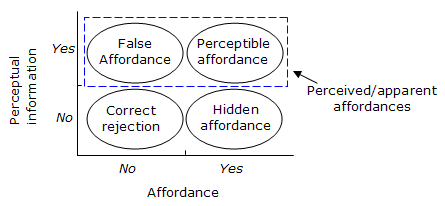The concept of an affordance was coined by the perceptual psychologist James J. Gibson in his seminal book The Ecological Approach to Visual Perception. The concept was introduced to the HCI community by Donald Norman in his book The Psychology of Everyday Things from 1988. There has however been ambiguity in Norman's use of the concept, and the concept thus requires a more elaborate explanation.
Updated Version of this Chapter:
Please see Victor Kaptelinin's chapter on Affordances and Design
5.0.1 Norman's use of the term
According to Norman (1988) an affordance is the design aspect of an object which suggest how the object should be used; a visual clue to its function and use. Norman writes:
"...the term affordance refers to the perceived and actual properties of the thing, primarily those fundamental properties that determine just how the thing could possibly be used. [...] Affordances provide strong clues to the operations of things. Plates are for pushing. Knobs are for turning. Slots are for inserting things into. Balls are for throwing or bouncing. When affordances are taken advantage of, the user knows what to do just by looking: no picture, label, or instruction needed." (Norman 1988, p.9)
Norman thus defines an affordance as something of both actual and perceived properties. The affordance of a ball is both its round shape, physical material, bouncability, etc. (its actual properties) as well as the perceived suggestion as to how the ball should be used (its perceived properties). When actual and perceived properties are combined, an affordance emerges as a relationship that holds between the object and the individual that is acting on the object (Norman 1999). As Norman makes clear in an endnote in Norman (1988), this view is in conflict with Gibson's idea of an affordance (explained next).
5.0.2 Gibson's use of the term
As opposed to Norman's use of his term, Gibson intended an affordance to mean "an action possibility available in the environment to an individual, independent of the individual's ability to perceive this possibility" (McGrenere and Ho, 2000). Unlike Norman's inclusion of an object's perceived properties, or rather, the information that specifies how the object can be used, a Gibsonian affordance is independent of the actor's ability to perceive it. A door can have the affordance of 'openability' (its affordance relative to the actor) but can be hidden, camouflaged or likewise (the information specifying its affordance are not available to the actor). On the other hand, when both the affordance (the door can be opened by the actor) and the information in the environment that specifies the affordance (the door is visible, has a handle etc.) are present, a state of direct perception is reached. "For example, one will perceive that one can walk forward when one sees a solid, opaque surface that extends under one's feet. The affordance is walkability and the information that specifies walkability is a perceived invariant combination of a solid, opaque surface of a certain size relative to oneself" (McGrenere and Ho, 2000: p.2). Direct perception means that the information in our sensory receptors is enough to perceive anything. We do not need any higher-level cognitive processes to mediate between our sensory experience and our perception (Sternberg 1997).
An affordance according to Gibson exists relative to the action capabilities of particular actors. Therefore, to a thief an open window can have an affordance of "climbing through" (and subsequently stealing something), but not so to a child who is not tall enough to reach the window and therefore does not have the action possibility.
Affordances, according to Gibson, should furthermore not be viewed as dependant on culture, prior knowledge or expectations of the individual, which Norman suggests. By disregarding knowledge and expectations of the actor, Gibson focuses only on the action capabilities of the actor and not, like Norman, on the perceptual and mental capabilities. However, the information that specifies the affordance is indeed dependant on the actor's experience and culture.
Gibson's Affordances
- Action possibilities in the environment in relation to the action capabilities of an actor
- Independent of the actor's experience, knowledge, cultre, or ability to perceieve
- Existence is binary - an affordance exists or it does not exist.
Norman's Affordances
- Perceived properties that may not actually exist
- Suggestions or clues as to how to use the properties
- Can be dependent on the experience, knowledge, or culture of the actor
- Can make an action difficult or easy
Figure 1: Comparison of affordances as defined by Gibson and Norman (McGrenere and Ho, 2000).
In other words, the misunderstanding regarding the definition of affordances has arisen because of Norman's ambiguous use of the term and his lack in separating affordances from the perceptual information that specifies the affordances. Gaver (1991) has contributed with a framework for separating affordances from the perceptual information available about them. See figure 2:
Figure 2: Seperating affordances from the perceptual information that specifies affordances. Adapted from Gaver (1991).
In figure 2, a 'false affordance' exists when there is no action possibility but the information that specifies it is (for example, a chair that look sturdy, but which is made of cardboard). A 'correct rejection' exists when there is no affordance and no perceptual information to specify it whereas a 'hidden affordance' exists when the affordance is there but the specifying perceptual information is not (for example, a hidden door). To compare the above classification of affordances to Norman's sense of the term, both 'false' affordance' and 'perceptible affordance' is comparable with Norman's 'perceived affordance'. According to Norman, the decisive factor is the perceptual information, so when it is there, regardless of whether the actual affordance also is, we may talk about a perceived affordance in Norman's sense of the term (indicated by the blue, dashed line).
5.0.3 Does establishing a clear meaning the distinction make a difference?
The distinction between Gibson's and Norman's sense of affordances allows us to distinguish between the utility/usefulness and the usability of an object: We both design for usefulness by creating affordances (the possibilities for action in the design) that match the goals of the user (the relativity of the affordance vis-à-vis the user) and we improve the usability by designing the information that specifies the affordances (perceptual information as shadows on buttons to afford clickability etc.).
5.0.4 Want to learn more about affordances?
If you want to learn more about affordances a good place to start would be to read Gaver (1991). After that you may read the original work by Gibson, which is chapter 8 in Gibson (1979). If you would like to more thoroughly understand affordances in the light of Gibson’s Direct Perception theory you may read chapters 3, 5, 6, 7, 8, 12, 13, and 14 in Gibson (1979) which should be enough to understand his theory (you can, of course, also read the whole book).


